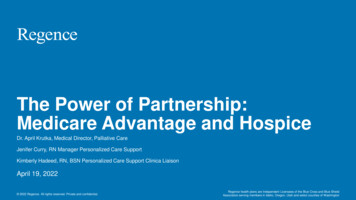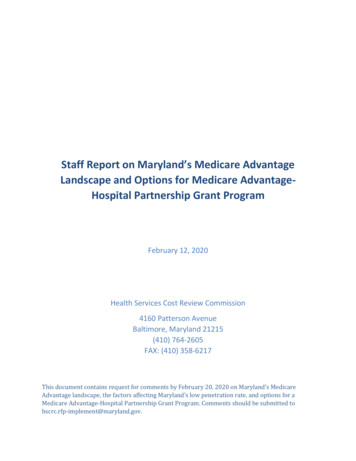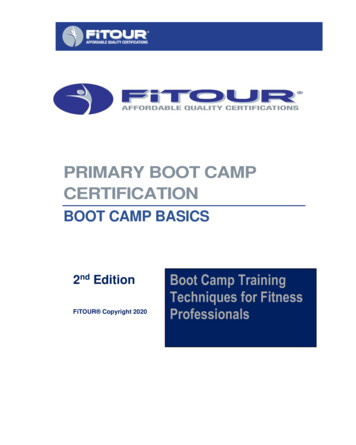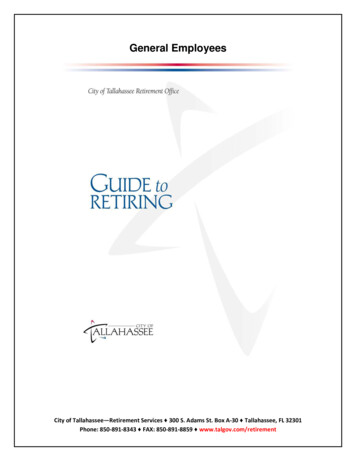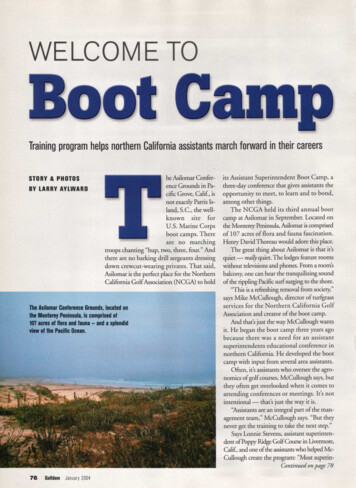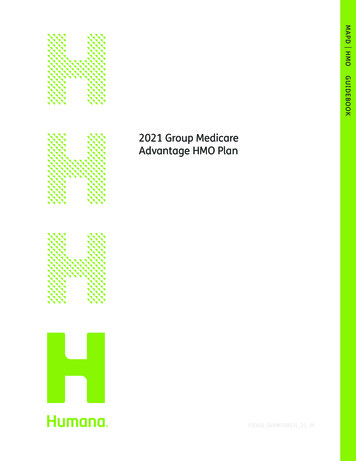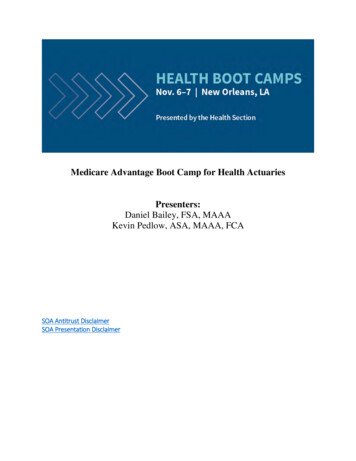
Transcription
Medicare Advantage Boot Camp for Health ActuariesPresenters:Daniel Bailey, FSA, MAAAKevin Pedlow, ASA, MAAA, FCASOA Antitrust DisclaimerSOA Presentation Disclaimer
Original A/B Medicare andMedicare Advantage Part CorMedicare Advantage—What’sThe Advantage?!?Daniel Bailey, FSA, MAAAACUMEN ACTUARIAL1
Overview—Medicare in 2017 55 mil Medicare beneficiaries (“benes”): 84% are 65; 16% disabled; 0.9% ESRD.More Pt A benes than B. Medicare (also called Original Medicare, A/B Medicare, orFFS Medicare) is a 2-part medical plan for acutecare—like Basic Hospital & Supp Major Medical Has potentially significant beneficiary cost-sharing Parts A & B of Medicare are not to be confusedwith “private” Medicare Advantage (MA)medical coverage called Part C—almost 1/3 ofbenes are enrolled in MA Pt C. (Private drug program is Part D) Terms: MA, PD, MA-PD, PDPACUMEN ACTUARIAL2
Medicare and Med Adv Part COverview:1. Facts and Fundamentals of Each,Some Basic Terms; Original FFSA/B Medicare distinguished fromMed Adv (Part C)2. Enrollment; Plan Design/AV/BeneCost-sharing; Regulation; Issues3. ConclusionACUMEN ACTUARIAL3
FFS Medicare—Part A and Part B Part B: In 2017, there’s a 183 ded ( 166 last yr) &20% coins on most care. ( 70% of benes pay avg 109/mo premium—higher income pay more) Part A: potentially high cost-sharing, esp. on longInP and SNF stays. 1,316 “ded.” for 60 InP days Pt A has # days limits—may have sentinel effect—disincentive to use Pt A Medicare as LTC benefit There is no maximum out of pocket (MOOP)expenditure on A/B Medicare—uncapped liability [NOTE: Medicare Advantage (MA) Part C plans musthave a maximum OOP of 6,700 or less in 2016.]ACUMEN ACTUARIAL4
FFS Medicare—Part A and Part B The traditional Medicare plan began in 1965; littlechange in benefit except indexing—its design is notunlike commercial health ins. plans of 1960’s.– Odd ”benefit period” definition of inpatient stays– # days limits on Inpatient and SNF– No A/B prescription drugs (small amt Pt B RX injectibles) Provider reimbursement structure evolved tocontrol cost around the inherent benefit design.Plan design on Pt A is limited to acute care—there isno LTC custodial cvg. due to Part A days limitsACUMEN ACTUARIAL5
MEDICARE PLAN DESIGN & RISKQ: What’s the 2017 Actuarial Value of Medicare?A: Based on latest 2017 USPCC, it’s about 83.3% 825.00 / ( 165.16 825.00 ) excludes ESRD benes(Stable since A/B cost-sharing parameters are indexed)Better than ACA “Gold”. As “rich” as commercial group mrktavg. But AV alone is an inadequate measure of beneficiarycost-sharing risk because FFS MCare has NO OOP MAX.And don’t compare with Commercial unless you add Pt D.The cost-sharing risk to Medicare bene may arisefrom a long Inpatient stay during a “benefit period”(and SNF stay). A very small % of FFS benes have veryhigh cost-sharing in tail of OOP distribution.ACUMEN ACTUARIAL6
Original Medicare Cost-Sharing RiskWithout a MOOP, Medicare beneficiaries have largecost-sharing exposure due to possibility of a lowfrequency, high severity claim, esp. 365 day Inpatientstay or long SNF stay. To reduce risk, the nonMedicaid Medicare beneficiary may:1) fill-in A/B 16% cost-sharing gaps w/ a Medigap plan(can’t buy supp for commrcl Exchange plans), or2) replace A/B Medicare with Part C Med Adv plan.(Some benes already have Employer Sponsored coveragewhich supplements A/B, & hence do not need gap cvg.ER cvg is in decline. Pre-2006 Part D, ¾ of their cost wasfor pharmacy coverage.)ACUMEN ACTUARIAL7
Original Medicare Cost-SharingMed Adv approximates Medicare Medigap (and ittypically throws in free Part D). Which is better?Depends on richness of MA and Medigap plans—someMA plans are close to Medicare in value, but all MAplans have a MOOP. (Consider medical only for now andignore Pt D )MA plans typically have more c/s gaps than Medicare Medigap. Orig MCare has no MOOP. Most Medigap sold also has no MOOP;but no need—it substantially reduces or eliminates cost-sharing.(MOOP exists on the less rich K & L Medigap plans w/ partial gapcoin. on Part B coins. K & L have small market share. )ACUMEN ACTUARIAL8
MA enrollment grew over past decade almost 3-fold:10% each yr for past two, despite revenue concerns: 15 mil Part C MA in (US Territories)—14.5 mil is“prepaid”; remaining 500k is “Cost” plans (1876and 1833 plans) and demos 13.5 mil (88%) of MA members are in MA plansthat include a Part D benefit (called MA-PD plans) The other 1.8 mil in plans called “MA-Only”(Unlike Med Supp, MA replaces Original Medicare.)ACUMEN ACTUARIAL9
Other Facts and Distinctions (Note—Standalone Part D is called PDP—22.7 mil beneficiaries in separate PDP (mutuallyexclusive of MA members w/ PD)—this is asubset of all Part D members. In total, there are 35.8 mil Medicare benes w/drug coverage through the Part D programwhich began in 2006 (35.8 13.1 MA-PD 22.7 PDP ). Most of others are in TriCare,FEHBP, or have ER cvg with “RDS”.ACUMEN ACTUARIAL10
Product Combinations & Sales RestrictionsWHAT IS PERMISSIBLE? Cannot buy Med Supp and Med Adv, and Cannot purchase PDP and Indiv MA-PD,but Can buy Med Supp PDP (& stay inOriginal FFS A/B Medicare) Insurers cannot sell Health Exchangeplans to Medicare beneficiariesACUMEN ACTUARIAL11
MA—Many Contract/Plan Types NOT ALL MA CONTRACT TYPES ARE THE SAME!!About 82% members in Individual plans; the rest isGroup (EGWP)—% varies substantially by carrier;some of Group is conversion from ER sponsored.Almost 2/3 of MA membership is in HMO plans;the rest is mostly PPO, most of which is LPPO (PFFStransitioned/ing into RPPO)Almost 93% are Local plans (HMO and LPPO)About 12% of MA members are in Special NeedsPlans (SNPs)—higher morbidity (risk scores) &greater opportunity of coordinated care savingsACUMEN ACTUARIAL12
All Medicare Advantage Part C Members15Enrollment by Year--Medicare Advantage, Grp & Indiv14.31413.11311.912Enrollment 92010201120122013YEARMedicare AdvantageACUMEN ACTUARIAL13
Med Adv, Medicare, & MA Penetration %Enrollment by Year--Med Adv and Medicare4950Enrollment 21.620 01120122013YEARMed AdvMedicareMed Adv Penetration %ACUMEN ACTUARIAL14
Enrollment by Year--Med Adv and Med Supp1514.313.1Enrollment 2013YEARMed AdvMedigapACUMEN ACTUARIAL15
MA must cover everything Medicare does; (perhaps alsogive extra benefits that Medicare does not); MA costsharing must be actuarially equiv or better than FFS A/B Extra benefits, depending on rebate amount, are either:1. reduced member cost-sharing on Medicare cvd benefits2. additional benefits that Medicare does not cover, such aspharmacy, eyeglasses, hearing aids, dental; Unltd InP days,broader chiro than A/B covers, out-of-country health care, 0 premium MA plan could also pay for some or all ofmember’s Part B premium (if sufficient rebate permits) MA plan value decreases each year as lift declines: 0 prem plans becoming more scarce,monthly member premium is increasing.ACUMEN ACTUARIAL16
Part C Plan Design—AVQ: What’s the Actuarial Value of Med Adv? (N/D)A: It depends on the MA plan.(What’s in the Dnmtr?Is it FFS A/B Medicare, or is it the Med Adv plan?)If Denomtr is MA, it varies. What’s cvd? Benft differences?Case 1: Same N and D—Same plan of benefits & costsharing— about 84%.Case 2: Enhance N—Less member cost-sharing but noadditional non-cvd benefits. 84% to 100% (theoretically).Like MedigapCase 3: Enhance D—Additional non-Medicare coveredbens, but actuarially equiv cost-sharing on all else. (Dependson the delta in each of N and D—cost-sharing on extras? )Case 4: Enhance N and D: (Dade county). Low c/s big D.ACUMEN ACTUARIAL17
Member Cost-Sharing for the MedicareElderly & Disabled Population Cost-sharing matters more for the MCare pop. becausebenes have 1) more medical spending, and 2) less income Ded, Coin, and Copays act as deterrents to marginal orunnecessary utilization, but have decreasing efficacy asmember income/wealth increases. (Bill Gates is not likelydeterred by a 45 spec. copay as much as the avg. bene.)– 1/2 of Medicare benes live on less than 23k annually!– Benes may receive Medicaid to fill-in A/B cost-sharing gaps (ifthey qualify based on income-assets test) and LIS for Pt D, ) Cost of premium is also an issue! What’s the AV of FFS A/B Med Supp? (C/S is complement) IT IS DIFFICULT For BENEsTo SEE TOTAL COST PICTURE! 18ACUMEN ACTUARIAL
Which Original Medicare Benes HaveThe Most Cost-Sharing? On avg, Pt A AV is 90.6%; Pt B—78.5% (CMS “Announcement”) Pt B: Due to 20% coins and indexed ded, cost shrng isclose to 20% of cost. (No c/s on preventive, Home Hlth) Pt A c/s amounts are also COL indexed, but per day c/samt. increases in steps for InP and SNF stays, and cuts offentirely at 90 – 120 days. 20% for Inp & SNF on average( 7%, 14%: Wks 5)—but can be substantially more forsome individuals with long duration InP & SNF stays. 2013 Cost by Age Study sponsored by SOA shows oldestbenes w\ highest allowed cost have a disproportionatelylarge portion of cost shrng. “Health Care Costs FromBirth To Death”—SOA report and data.ACUMEN ACTUARIAL19
—Medigap v. MA Medigap is regulated by & filed w/ state—variesstate to state; some federal rules (Guar Issue) Some states have COMMUNITY RATED Med Supp Med Adv (MA) is regulated by & filed w/ federalgovernment via CMS under HHS (85% MLR) Complexity of bidding has increased as MA-PD regltnhas evolved; in addition to claims projection, riskscore & revenue projection complicates MA further Multiple constraints on Med Adv bids—very timebound, total benefit change (TBC) is limited yr to yr,MOOP, MSP, DE#, permissible plan differences,margin guidelines, MLR, dynamics of updatedfactors, mid-bid- season regltry changes, etc ACUMEN ACTUARIAL20
Two Primary Advantages:1. Cost savings attributable to medicalmanagement & coordination of care.(But PCMH and ACO are now growing in FFS Medicare space)2. Lift in county-specific benchmarkrevenue rates (which are decreasingover time in a complicated manner).(Which quartile does the county fall in, and is transition 2, 4, or 6 yrs?)ACUMEN ACTUARIAL21
Med Supp vs. Med AdvMed Adv, MA-PDMed Supp, Plan F Copays vary by type ofservice– Prof (Pt B) copaysusually less than 20% Includes PD (often free!) Includes OOP Max 6,700or less Premiums do not vary byage--CMS revenue does!Age is part of Risk Score Covers all cost-sharing forParts A & B includingdeductibles and coins Does NOT include PD NO OOP Max, but notnecessary Premium varies by age,unless COMMNTY RTD—NJ 65 yr old cost 85 yrACUMEN ACTUARIAL22
MORE ODIOUS COMPARISONS MED ADVANTAGEMED SUPP 3x growth in 10 yrs MLR of 85%, hencecompression on cost 3% Profit on 900 PMPMrevenue is better thanMed Supp May be a network Ongoing challenge ofPayment Reform Was eclipsed by MA-PD Much lower MLR, butmarket forces LR higher. A 8% profit on 150PMPM premium is lessthan MA-PD Has Medicare ntwk Poor Value Proposition,but improving ACUMEN ACTUARIAL23
Medicare Advantage—What’s The Advantage?!? Was title of my 2006 MA presentation aroundtheme of “The MMA— One Year Later”—MAutilizes med mgmt that did not exist in OrigMedicare at that time hence MA can reducecost & offer richer benefits than Orig MCare. But under MA, bene gives up the freedom touse any provider who takes MCare assignment;and must use MAO’s CCP network. And MAO has significant admin cost handicapto perform at overall cost parity with Medicare.ACUMEN ACTUARIAL24
Part C Issues and Challenges STARS Ratings are a proxy for total Quality—highquality contracts have a competitive advantagefor two primary reasons:1. Bonus higher PMPM benchmark revenue2. Larger bid “rebate” as percentage of savingsAll else equal, plan w/ higher STARs rating is preferred.4-Star Cliff in 2015—5% or nothing (unless demo extended) Difficult MA-PD bid reallocation last August (and thetwo Augusts before)—Some surprised by PD #s released.(See next page about bid reallocation.)ACUMEN ACTUARIAL25
Part C Issues and Challenges Benchmark Revenue Rate and LiftCompression— Revenue is county-specific;“Lift” in each county’s benchmark rate has beendecreasing in a complicated way—the 4 Quartiles; 2, 4, or 6 yr transitions (ends in 2017) Stuff happens—sequestration; ICD-10; where canwe find several of bnft cuts in Aug. PD re-alloc? Marketplace actions, reactions: acquisitions, The list goes on and changes over timeACUMEN ACTUARIAL26
Original Medicare is a generous plan w/low avg cost-shrng, but highc/s risk for a very small portion of benes due to no MOOP. Medicarepopulation has limited means; c/s hits benes harder; (this is afundamental financial security issue all nations with aging pops mustaddress) In most places, Med Adv is usually a better deal (more affordableand more low-cost options) than staying in FFS Medicare and buyingMed Supp and PDP:-- This is currently more true in urban locations where Indiv MA-PDplans are plentiful and networks are robust. Later?-- “Better deal” is less prevalent in rural areas where there’s less geoaccess to mgd care MA networks; counties in 4th Quartile will ultimatelyhave 15% lift in lowest cost counties—other factors play a role. Later?Although some growth in group is simply conversion, given MA’s enrollmentgrowth in past decade, we’ve come a long way since the managed carebacklash in the late 1990’s.ACUMEN ACTUARIAL27
Enjoy Your Stay in New Orleansbailey-d-1@comcast.netACUMEN ACTUARIAL28
Overview—Medicare in 2017 55 mil Medicare beneficiaries ("benes"): 84% are 65; 16% disabled; 0.9% ESRD. More Pt A benes than B. Medicare (also called Original Medicare, A/B Medicare, or FFS Medicare) is a 2-part medical plan for acute care—like Basic Hospital & Supp Major Medical Has potentially significant beneficiary cost-sharing

